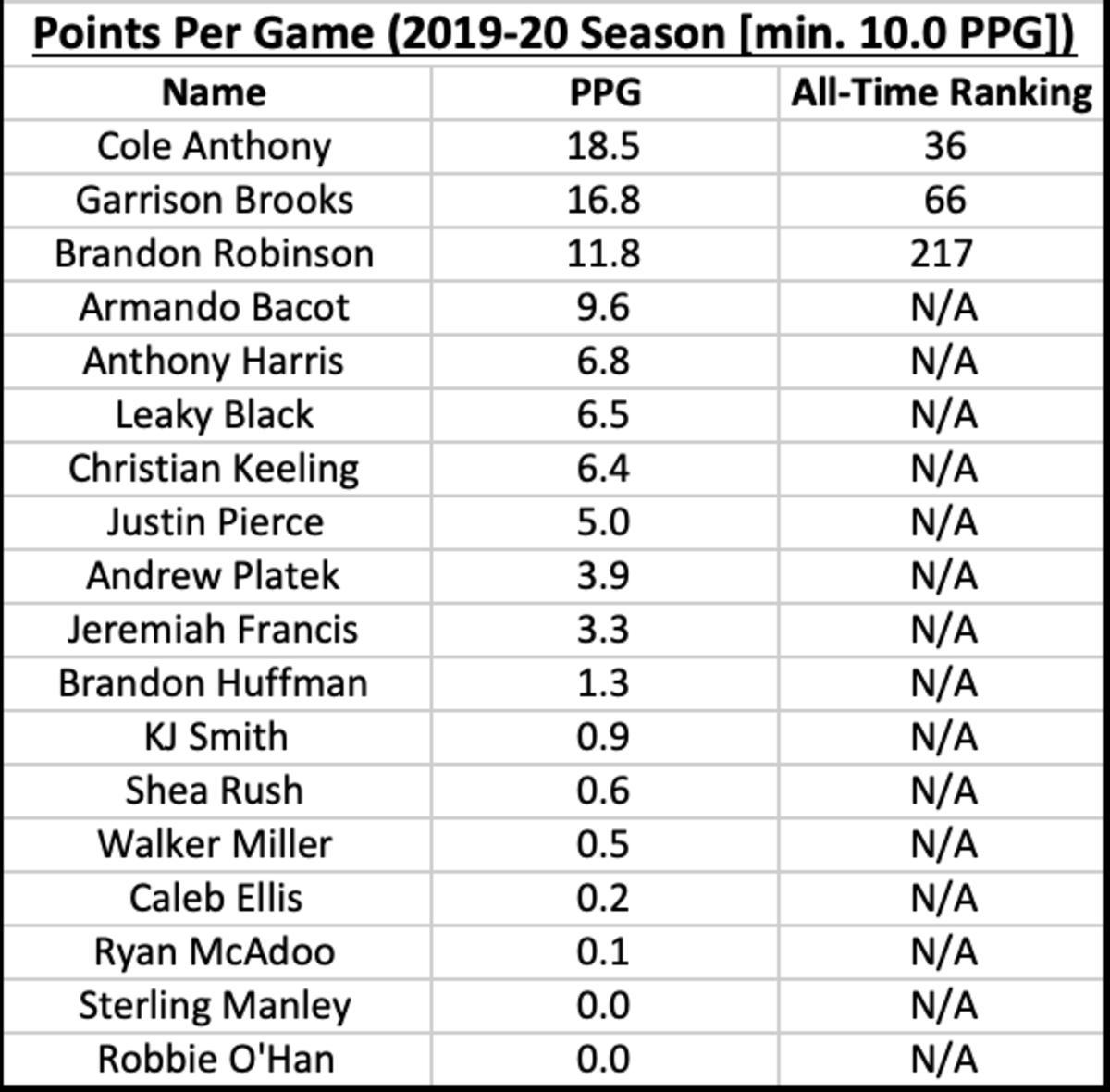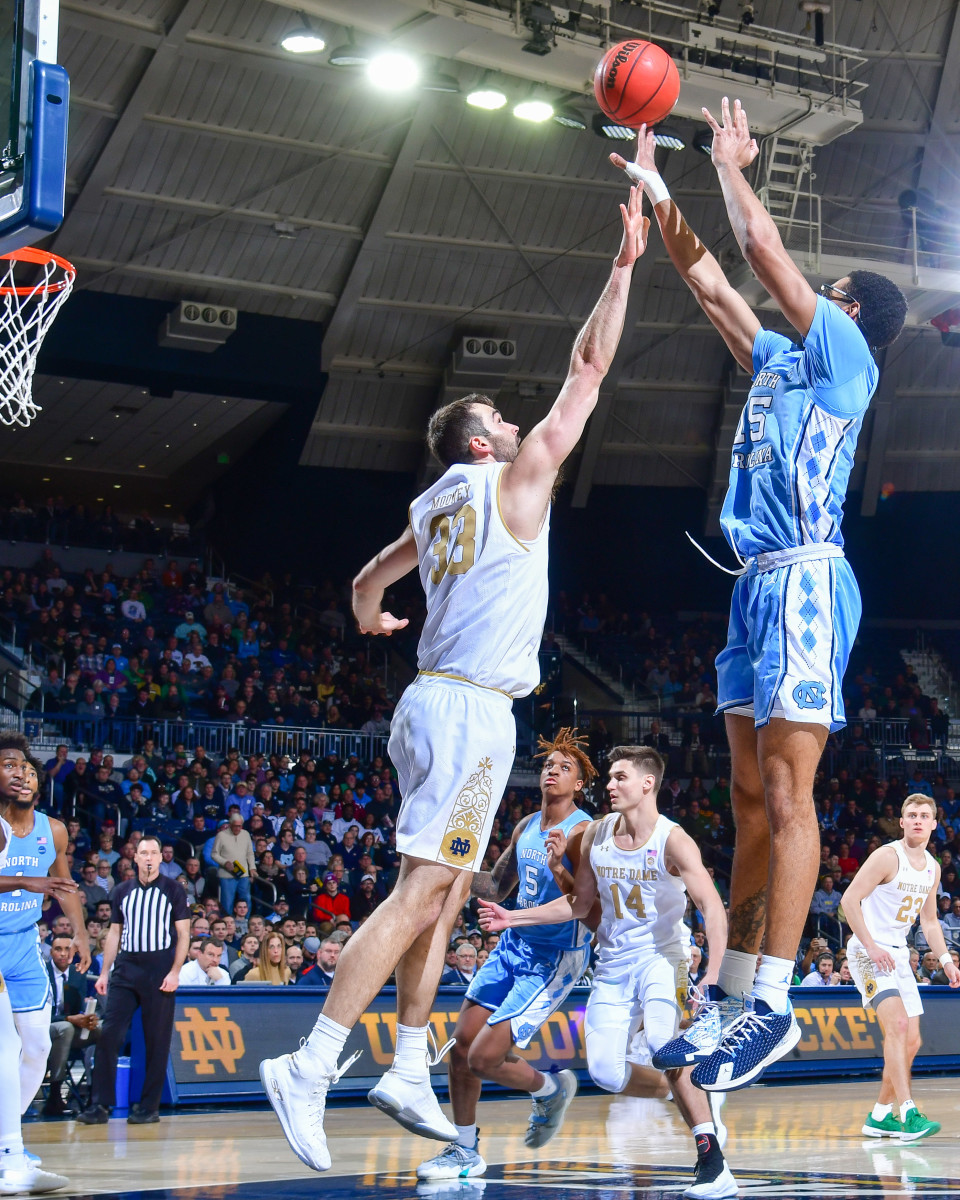UNC Basketball: 2019-20 Stats in Review - Points Per Game
It’s no secret: North Carolina basketball is go, go, go. The ball goes through the hoop for the opponent and within five seconds Ty Lawson or Coby White has already converted a lay-up.
Or Kendall Marshall has already pitched ahead to a streaking Harrison Barnes or Tyler Zeller.
Or Cam Johnson has knocked down a dead-eye transition three.
It’s just what Carolina does.
It’s why I call my game recaps “Quick Hitters”. Everything for Tar Heel basketball must be quick snippets, so too, must be the recaps.
10 of Roy Williams’ 17 Carolina teams have averaged 80 points a game for the season. At Virginia’s pace, they’re happy to score 80 TOTAL points in a season.
Nine of Roy Williams’ 17 Carolina teams have ranked in the top 10 in KenPom adjusted offensive efficiency (points/100 possessions). Three of those teams have ranked number one. If you expand those numbers to the KenPom top-13, 12 of the 17 Roy Williams Carolina teams qualify.
Carolina knows how to score.
Carolina knows how to score quickly.
Carolina knows how to score a lot.
Imagine our surprise then, when a season like 2019-20 hits and suddenly Carolina doesn’t know how to score, or how to score quickly, or how to score a lot.
Roy Williams warned us before the season even started. But who believed him? I sure didn’t. I should have.
These Tar Heels never scored 100 points. No one got biscuits. No one got Bojangles (Oh man, could I go for a Bo-Berry Biscuit right about now).
In fact, it took until game 11 for Carolina to even score 80.
And though it appeared they might never hit 90, they finally did in game 19 as Roy Williams moved ahead of Dean Smith on the all-time Division 1 wins list.
Such is life in sports. The unexpected happens. Thankfully the history books will remember this season as the COVID-19 season and we will turn the page to 2020-21.

Over the course of the past several weeks, I’ve been reviewing the stats from the 2019-20 North Carolina basketball team, one category at a time. We’ve already looked at total points, total rebounds, total assists, total three-pointers, total blocks, total steals, field goal percentage, and free throw percentage. We move today to points per game.
As a reminder: while these stats won’t tell the whole story of the season, they will help provide context and insight for both the present and historical context.
The following chart lists each player, their points per game average for the season, and where they ranked in the Carolina history books for points per game in a single season (for those who achieved the minimum threshold of 10.0 points per game).

Observations
- Three different Tar Heels averaged double digits for the season – Cole Anthony (18.5), Garrison Brooks (16.8), and Brandon Robinson (11.8).
- For the record, Armando Bacot was right on the cusp, averaging 9.6 points per game. Had he scored 12 more points, his average would have been exactly 10.0.
- Cole Anthony led the team with 18.5 points per game. That’s the highest points per game average for a Tar Heel since Tyler Hansbrough’s 20.7 in 2008-09.
- In fact, Anthony’s 18.5 points per game was the fifth-highest average of the Roy Williams era. He trails only Rashad McCants in 2003-04 (20.0), and three versions of Tyler Hansbrough (2005-06: 18.9; 2007-08: 22.6; 2008-09: 20.7).
- Only four players averaged more than seven points per game. Every other Roy Williams Carolina team has had at least five players average 7.0+ points per game.
- This has nothing to do with 2019-20, but three UNC teams in the Roy Williams era have featured five players averaging double-figures: 2004-05 (starters, minus Jackie Manuel, plus Marvin Williams), 2008-09 (starters), and 2017-18 (starters). Interestingly, it’s two National Champion teams and a team right after a National Championship.
- Anthony and Brooks combined to average 35.3 points per game. That’s the third-highest combined total in the Roy Williams era of the top two scorers. As you can probably imagine, they were bested by Hansbrough and a teammate. In 2008-09, Hansbrough and Ty Lawson averaged 37.3 points per game and in 2007-08, Hansbrough and Wayne Ellington averaged an absurd 39.2 points per game.
- As a team, Carolina averaged 72.2 points per game. That’s the lowest average since the 2002-03 team scored 72.1 points per game in Matt Doherty’s final season.
- Not only did the Tar Heels average 72.2 points per game, but their opponents averaged 72.8 points per game. The last time Carolina’s opponents averaged more points per game total for the season was 2001-02 (72.2-78.9). Prior to that, Carolina hadn’t been outscored by their opponents for the season since the 1961-62 Larry Brown-led team scored 1230 points to the opponents’ 1235.
Conclusions

Numbers and stats don’t tell the whole story, but they do help tell the story. So what story do these numbers help tell?
The Tar Heels are losing two of their top three scorers next season (Anthony and Robinson), but bring back four of the top six (Brooks, Bacot, Anthony Harris, and Leaky Black). Several of the incoming freshmen are known as prolific scorers, which will hopefully help round out the offense.
While many have pointed to Cole Anthony’s inefficiency at times throughout the season, he seemed to be really finding his stride down the stretch and started clicking with Garrison Brooks. Looking at his points per game numbers, you can’t help but wonder what could have been if he hadn’t missed 11 games.
As pointed out multiple times, the 2019-20 team just flat out struggled to score. Injuries played a role. Talent played a role. Cohesion played a role. It’s not something we need to try to explain away, it just is what it is. Hopefully, it’s a one-year blip and the 2020-21 team (assuming there is a basketball season) will get right back on the horse.
Hearing the determination in Roy Williams’ voice on an interview with Jon Rothstein last week, it’s safe to say that this group of young men will have no other choice than to raise their offensive capabilities in the upcoming season.
We conclude our series of examining the 2019-20 UNC stats on Friday, June 19. Next up: Three-point percentage.
You can follow us for future coverage by clicking “Follow” on the top right hand corner of the page.
Send Isaac Schade an email to talk more about this article.
Follow us on Twitter: @SI_Heels | @isaacschade
Please post any comments below!
